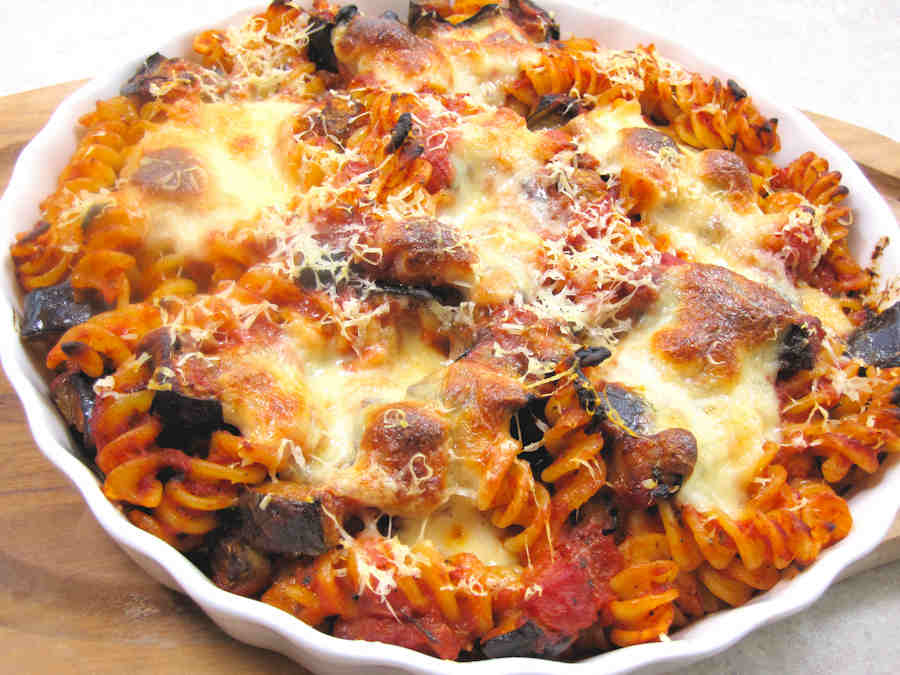Easy, comforting and vegetarian. Is there a better combination than aubergine, tomato and pasta?

Which pasta shapes for which sauce?
Pasta shapes are supposed to be dressed with appropriate sauce.The chunky shapes: penne, fusilli, farfalle, are for robust sauces while the long, thinner strands need to be served with creamy, delicate dressing.
Spaghetti bolognese, Britain's favourite pasta dish is apparently an abomination because in Italy spaghetti wouldn’t be seen dead (or served up) with meaty ragù. Apparently it’s supposed to go with tagliatelle or pappardelle, but then those are also long, thin strands. Who can understand Italians?
With pasta sauce, less is more
Life seems far too short to ever try all the pasta shapes, there are so many. I’m really not quite sure whether I personally prefer the chunky pasta shapes or the long, challenging ones but I have some rules of thumb of my own.
One is to serve long pasta fresh, tossed with creamy sauce of one kind or another. Here less is more, as you want to flavour the noodles, rather than drown them. That’s why the quality of pasta is important.
Another of my pasta rules is to match tomato sauce with chunky shapes. It will cling to the twists and holes obediently instead of sitting in a puddle on the plate at the end of the meal. Less is more applies here too. I had the best pasta ever in Umbria: the sauce was hardly discernible and yet the tomato flavour was intensely superb.
Which shapes for pasta bake?
For pasta al forno I usually stir chunkier shapes into sauce: fusilli, penne, rigatoni or conchiglie. I decadently add some extra mozzarella slices and bake until the dish is crisp on top. The bubbling cheese, the scorched fusilli, there surely isn't a more comforting dinner than pasta straight from the oven.
How to mix pasta with sauce?
Hopefully we all know that pasta likes to be boiled in plenty of salty water without adding any oil to it when drained. The most efficient way - and how the nonnas do it - is to cook your sauce in a pan large enough to contain the drained pasta as well. Never, ever spoon the sauce on top of a pile of noodles. It needs to impart the flavour to pasta while still cooking awhile. And always slosh a little cooking water to the sauce together with the pasta.
How to make good tomato sauce?
It is very, very easy. A tin of tomatoes or a jar of passata will make very good sauce. Of course you can use fresh tomatoes but unless they are very ripe, you are actually better off with tins.
A little oil, a clove of garlic, salt and pepper and a drop of honey - and the secret is in long cooking. It will annoyingly splatter all over the hob but best to cook it uncovered. Forty minutes is the minimum and the longer the better - within reason of course.
My tip is to cook three or four times as much in a huge vat, decant it into tubs or freezer bags in portions and have months of pizza and pasta sorted.
Can I use shop bought tomato sauce?
Reluctantly, yes. Nothing will beat homemade stuff and considering how easy this recipe is, it should be unforgivable to open a jar instead. But I am tolerant, open-minded and understanding.
Variations
Can you improve on a simple classic of aubergine and tomato pasta bake? No, but for the persistent variation seekers, here goes.
Vegan version: skip the cheese or use vegan equivalent.
Meat version: add some diced streaky bacon when cooking the aubergine.
Mushroom and tomato pasta bake: simply swap aubergine for mushrooms and proceed as per recipe. You can do the same with red peppers or courgette except cook the latter much less.